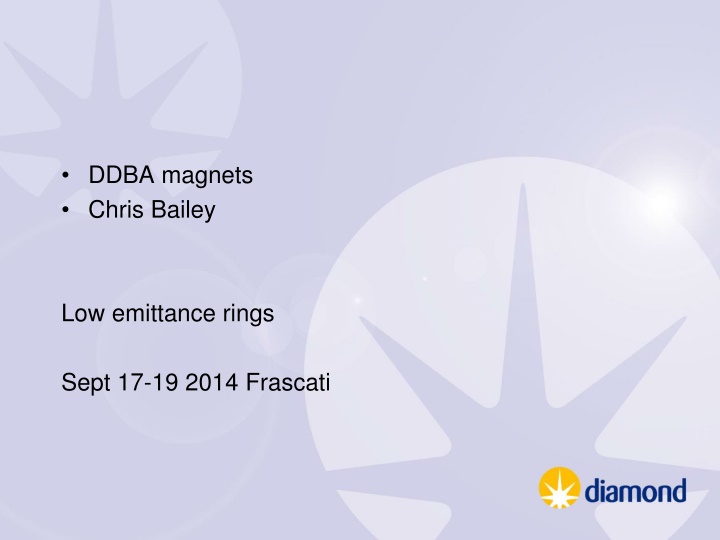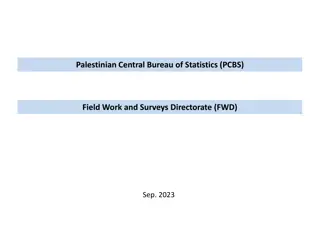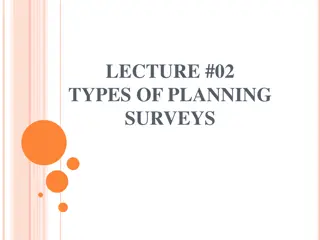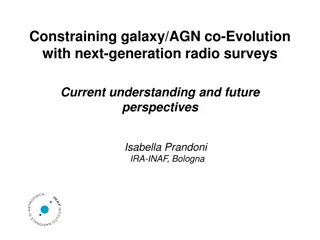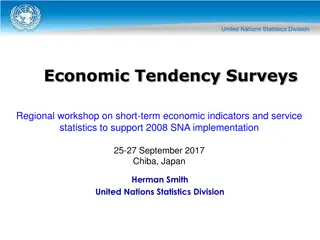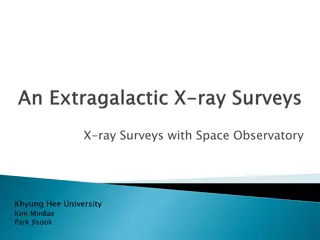Transitioning to Online Surveys for Module Evaluation: Advantages and Challenges
Shift from paper-based module evaluation to online surveys, examining advantages such as seamless digital experiences and quicker feedback turnaround, alongside challenges like initial development time and ensuring data integrity and security.
Download Presentation

Please find below an Image/Link to download the presentation.
The content on the website is provided AS IS for your information and personal use only. It may not be sold, licensed, or shared on other websites without obtaining consent from the author.If you encounter any issues during the download, it is possible that the publisher has removed the file from their server.
You are allowed to download the files provided on this website for personal or commercial use, subject to the condition that they are used lawfully. All files are the property of their respective owners.
The content on the website is provided AS IS for your information and personal use only. It may not be sold, licensed, or shared on other websites without obtaining consent from the author.
E N D
Presentation Transcript
DDBA magnets Chris Bailey Low emittance rings Sept 17-19 2014 Frascati
Outline DDBA What and why Where have we got to Choices affected by single cell Tolerances Each of the magnets Mountings Measurements Alignment and final setup
What is DDBA and Why Double Double Bend Achromat is a single cell upgrade based on the early Diamond II studies. Central part of modified cell emptied to give additional Insertion device space in ring. Is being used to provided additional beamline with more powerful Insertion Device than would be otherwise possible. Also gives experience and understanding of some of the issues involved in the design and build of low emittance lattice upgrade
Project status Cell 2 in progress. Magnet contract placed Vacuum vessels contract placed ? New girders ordered ? Temporary wiring for existing cell to make space for new wiring install in progress ? 2nd cell (11), approved awaiting funding confirmation, target 2 years after first cell. Beam dynamics work in progress, price for additional set of magnets included in contract
Schedule Milestone Milestone DLS (Specific ation) Aug 14 Current Schedu le Sep 14 Date Magnet contract placed Jun 14 Vacuum vessel contract placed Sep 14 Preliminary Design review Final Design review Feb 15 End Oct 14 Oct-Dec 14 Girders ordered Nov 14 Existing installation moved to temporary cabling Sep 15 DLS familiarisation with Measurement system Prototype magnet testing Delivery of Series magnets Re-measure magnets installed on girder (Final alignment) Girders Ready for install ---- Vacuum vessels Delivered Sep 15 Jun 15 Mar 15 Magnets Delivered Nov 15 Girders Assembled Apr 16 Nov 15 Sep 15 New cabling installed Jun 16 Nov-Dec 15 Front end for new beamline installed (partial) Jun 16 DDBA Cell installed and commissioned Aug / Sep 16 Apr 16 First Light to new beamline Jan 17
What are the implications of only changing a single cell Single variation of quadrupole and sextupole, only 2 variations of dipole. Match to existing power supply designs and cooling system. Choice of windings in Dipole. Some of the tolerance requirements are relaxed, compared to full ring. There will not be spare girders so needs to be possible to swap magnets. Length of Shutdown for install very short :- preparatory cabling
Lattice and Magnets Dipole 0.67 and 0.965 m 14.385Tm-1 0.8 T Central Quadrupole 0.25 m 70 Tm-1 Sextupole 0.175 m 2000 Tm-2
Errors and tolerances Request in specification Surface on dipole will only be possible to verify to 40 m due to distances to reference points. Surface tolerances 20 m Assembly tolerances 15 m Modelling work on full geometry models with errors is ongoing (slowly) and suggests there may be scope to relax tolerances slightly. Problems with models mean confidence is not high enough. Alignment system resolution and errors. Resolution 5 m Accuracy 10 m
Dipole Long Dipole with trim at 65A Integrated field components / nominal length Dipole parameters Nominal Field 0.8 T Dipole 0.800 T Gradient Length -14.385 Tm-1 0.670 & 0.96 7 m 19.8 mm 10 mm X 4mm Y Quadrupole 1.4315 Tm-1 Sextupole 0.2 parts 10^4 Minimum Gap Good field region Octopole 3.6 10 -3.2 12 0.9 14 -0.3 All others <0.1 Offset 825 m
Dipole : practical comments Manufacturing accuracy achieved by wire erosion of pole in place on main structure. All mating surfaces are flat. Poles are curved but back leg is straight. There are feature surfaces that should be parallel for measurement. The field is optimised by adjusting the length and depth of the pole noses. The strength of the integrated sextupole has been minimised by adjusting the angle of rotation of the end chamfers Lateral position is used to match field and gradient. 2mm adjustment. Longitudindal space is very limited Using 2 coils: 7-turns per pole on existing dipole circuit, & 12 turns 200A trim coil to adjust field. Advantage taken of smaller conductor for trim winding to mount inside the primary conductor . Probably requires separate manifolds Early designs had winding on back leg. This has been abandoned to improve structural rigidity of magnet.
Quadrupole Model fields Parts in 10^4 integrated field Quadrupole parameters Gradient Bore diameter Effective length Max length quadrupole 70 Tm-1 70 Tm-1 30 mm 0.250 m 0.322 m Octupole -4 20 Pole 2 All others <1 Gap between coils for extracted beam pipe 17 mm
Quadrupole: Practical comments Made from solid steel not laminations Will be finished by wire erosion of fully assembled yoke. Needs to be dismantled to fit coils. Pole flats to give measureable gaps Space constraints for coil significant issue, both at ends of magnet and clearance for photon beam pipe. Power in magnet, the quadupole circuit becomes the defining cooling circuit on each girder The poles are highly saturated
Sextupole Integrated harmonics parts in 10^4 Octupole 10 12 14 16 18 20 22 Sextupole parameters Effective length Physical length Bore radius Strength Integrated Corrector strength Horizontal Vertical Skew quad 0.175 m 0.232 m 15 mm 2000 Tm-2 2.4 3.7 0.5 0.4 1.5 -1.2 1.8 4.9 8 mTm 8 mTm 0.1 T
Sextupole: Practical comments Corrector windings included Horizontal, Vertical and Skew quadrupole. Laminated magnet: Fast Feedback Laminated poles to be oversized when assembled Final profiles achieved by wire erosion on fully assembled yoke Profiles give parallel surface to check assembly This magnet has reduced strength compared to sextupole required for full ring upgrade. Coils intended to use existing power supply modules. But small primary coils have lower than ideal resistance. We have chosen to maintain the conductor cross section as these windings also provide the cooling for the correctors Space to clear extracted photon pipe not so tight as in quadrupole, but the yoke is also limited on the outside, currently checking rigidity.
Mounting Still on girders. drives change from existing arrangement. Accuracy Range 1mm for multipoles, horizontal and vertical 2 Dipoles on each girder Ability to remove magnets once vessel is in place. Dipole adjustment, given greater range of transverse adjustment to allow correct setting of both field and gradient. Separate motion system to remove.
Measurement program. Multipoles:- ESRF-Stretched wire (alignment and higher multipoles) On 10 mm radius. 0 full current 10 steps. Offsets, rolls and Harmonics Measurements required in spec Dipoles Hall probe field scan (1mm intervals and interpolate) 2mm transverse lines on 0, 2mm, 4mm Vertically. On axis over range from 0.8 to 1.1 times operating point.
Alignment and final setup Initial alignment of multipoles, using measurements at works. Then check with same stretched wire system but mounted on final girder all multipoles present, adjust as required. Compensating masses for missing dipoles. Initial alignment of dipoles based on at works measurements, but radial adjustment to set correct field when gradient correct, using Beam based measurements during commissioning.
Conclusions Magnets on order at Danfysik, Final design review in October. There are still some mechanical design issues to be resolved, space is very tight. Schedule for delivery, of magnets, ahead of that required for install in 2016. Measurement and alignment program being developed. Cabling works to enable optimised shutdown already in progress.
